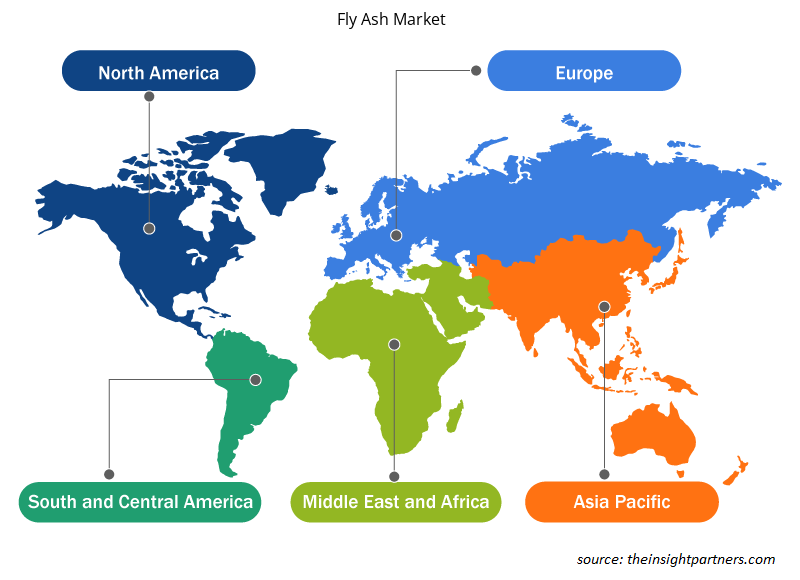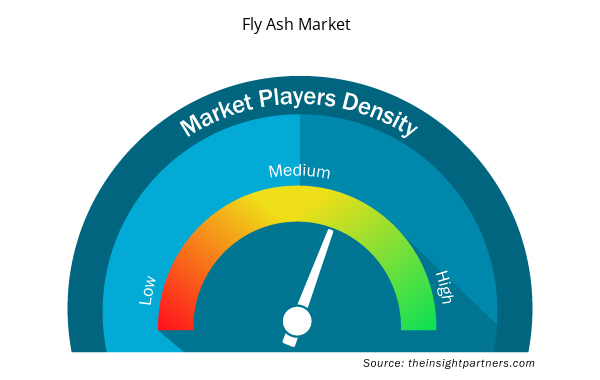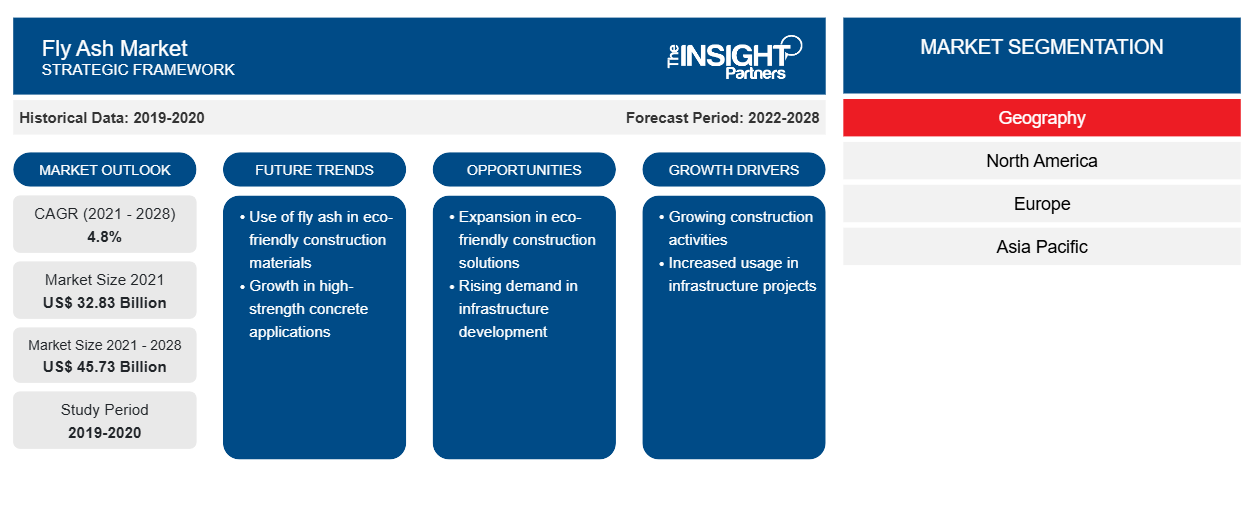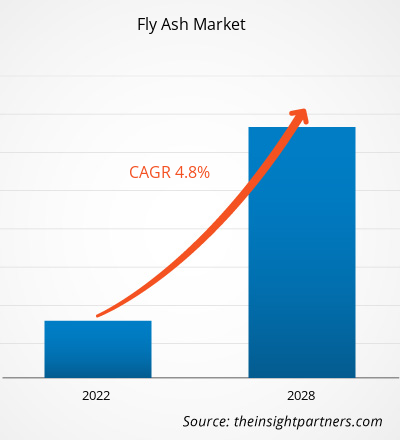[Forschungsbericht] Der Flugaschemarkt wurde im Jahr 2021 auf 32,83 Milliarden US-Dollar geschätzt und soll bis 2028 45,73 Milliarden US-Dollar erreichen; von 2021 bis 2028 wird ein durchschnittliches jährliches Wachstum von 4,8 % erwartet.
MARKTANALYSE
Flugasche entsteht als Verbrennungsrückstand und enthält feine Partikel wie Siliziumdioxid, Aluminiumoxid, Eisenoxid und manchmal Calciumoxid. Es handelt sich um ein feines graues Pulver mit puzzolanischen Eigenschaften, das mit Kalk reagieren und Zementverbindungen bilden kann. Flugasche wird in einer Vielzahl von Anwendungen eingesetzt, beispielsweise beim Mischen von Zement und Beton, in Bergwerken und Staudämmen, auf Mülldeponien und in Geopolymerbeton. Flugasche verbessert die Leistung des Betons beim Mischen und wirkt auch als Katalysator für die Umwandlung von Polyethylen während der Pyrolyse.
WACHSTUMSTREIBER UND HERAUSFORDERUNGEN
Das stetige Wachstum in der Bauindustrie treibt das Wachstum des globalen Flugaschemarktes erheblich an. Die Länder im asiatisch-pazifischen Raum wie die USA, China und Indien haben die größten Bauprojekte der Welt. Die hohe Bautätigkeit führt zu einer enormen Nachfrage nach verschiedenen Baumaterialien. Flugasche wird in zahlreichen bauspezifischen Anwendungen wie Zement, Beton, Ziegeln und Blöcken verwendet. Flugasche wird in der Bauindustrie zunehmend für eine Vielzahl von Anwendungen eingesetzt. Darüber hinaus treibt die zunehmende Verwendung von Flugasche in verschiedenen Anwendungen das Wachstum des globalen Flugaschemarktes weiter an. Flugasche wird in verschiedenen Anwendungen wie Zement und Beton, Blöcken und Ziegeln, im Bergbau, als Füllmaterial und für Dämme und viele andere verwendet. Aufgrund ihrer puzzolanischen Eigenschaft ist die Verwendung von Flugasche in Beton sehr vorteilhaft, da sie die Haltbarkeit des Betons verbessert. Bei der Herstellung von Portlandzementbeton wird Flugasche als ergänzendes zementartiges Material (SCM) verwendet, um die Leistung dieses Betons zu verbessern. Flugaschesteine werden als Baumaterial anstelle von Lehmziegeln verwendet. Im Vergleich zu herkömmlichen Tonziegeln sind Flugaschesteine leichter und robuster, kostengünstig, benötigen keinen Gips und können dazu beitragen, Baukosten und Bodenerosion zu reduzieren. Allerdings könnte mangelndes Bewusstsein über die Vorteile oder potenziellen Einsatzmöglichkeiten von Flugasche das Marktwachstum einschränken. Flugasche ist ein wichtiger Rohstoff für verschiedene Anwendungen. Es mangelt jedoch an Verständnis für die Chemie von Flugasche und ihren Derivaten, um sie in geeigneten Endanwendungen einzusetzen. Das mangelnde öffentliche Bewusstsein über die Produkte ist einer der Gründe für die geringe Nutzung von Flugasche.
Passen Sie diesen Bericht Ihren Anforderungen an
Sie erhalten kostenlose Anpassungen an jedem Bericht, einschließlich Teilen dieses Berichts oder einer Analyse auf Länderebene, eines Excel-Datenpakets sowie tolle Angebote und Rabatte für Start-ups und Universitäten.
- Holen Sie sich die wichtigsten Markttrends aus diesem Bericht.Dieses KOSTENLOSE Beispiel umfasst eine Datenanalyse von Markttrends bis hin zu Schätzungen und Prognosen.
SEGMENTIERUNG UND UMFANG DES BERICHTS
Die „Globale Flugaschemarktanalyse bis 2030“ ist eine spezialisierte und eingehende Studie mit einem Schwerpunkt auf den globalen Flugaschemarkttrends und Wachstumschancen. Der Bericht soll einen Überblick über den globalen Flugaschemarkt mit detaillierter Marktsegmentierung nach Typ, Anwendung und Geografie geben. Der globale Flugaschemarkt hat in der jüngsten Vergangenheit ein hohes Wachstum erlebt und wird diesen Trend im Prognosezeitraum voraussichtlich fortsetzen. Der Bericht liefert wichtige Statistiken zum weltweiten Flugascheverbrauch sowie zur Nachfrage in wichtigen Regionen und Ländern. Darüber hinaus bietet der Bericht eine qualitative Bewertung verschiedener Faktoren, die die Leistung des Flugaschemarkts in wichtigen Regionen und Ländern beeinflussen. Der Bericht enthält auch eine umfassende Analyse der führenden Akteure auf dem Flugaschemarkt und ihrer wichtigsten strategischen Entwicklungen. Mehrere Analysen der Marktdynamik sind ebenfalls enthalten, um die wichtigsten Antriebsfaktoren, Markttrends und lukrativen Flugaschemarktchancen zu identifizieren, die wiederum dazu beitragen würden, die wichtigsten Einnahmequellen zu identifizieren.
Darüber hinaus bieten die Ökosystemanalyse und Porters Fünf-Kräfte-Analyse eine 360-Grad-Ansicht des globalen Flugaschemarktes, die dabei hilft, die gesamte Lieferkette und die verschiedenen Faktoren zu verstehen, die das Marktwachstum beeinflussen.
SEGMENTANALYSE
Der globale Flugaschemarkt ist nach Typ und Anwendung segmentiert. Nach Typ wird der Flugaschemarkt in Typ C und Typ F segmentiert. Nach Anwendung wird der Markt in Zement und Beton, Block und Ziegel, Bergbau, Straßenstabilisierung, Aufschüttungen und Böschungen, Abfallstabilisierung und andere unterteilt. Nach Typ entfiel auf das Segment Typ C ein großer Anteil des Flugaschemarktes, was auf die zunehmende Verwendung von Flugasche in verschiedenen Anwendungen zurückzuführen ist. Flugasche Typ C wird häufig aus subbituminöser Kohle und Braunkohle gewonnen. Die besonderen selbsthärtenden Eigenschaften von Flugasche Typ C sind auf ihre hohe Konzentration an Branntkalk (CaO) zurückzuführen. Flugasche Typ C eignet sich am besten für Hochleistungsmischungen, vorgespannte Anwendungen und andere Anwendungen, die eine höhere Anfangsfestigkeit erfordern. Flugasche Typ C ist aufgrund ihres hohen Kalkgehalts sehr effektiv bei der Bodenstabilisierung. Basierend auf der Anwendung hatte das Segment Zement und Beton einen großen Anteil am Flugaschemarkt, was auf die zunehmende Verwendung von Flugasche im Bausektor zurückzuführen ist. Flugasche wird als ergänzendes Zementmaterial (SCM) zur Herstellung von Portlandzementbeton verwendet. Im Vergleich zu Portlandzementbeton mit gleicher Verarbeitbarkeit reduziert die Verwendung von Flugasche ausgezeichneter Qualität mit hoher Feinheit und niedrigem Kohlenstoffgehalt den Wasserbedarf von Beton. Infolgedessen sollte Flugasche die Herstellung von Beton mit einem geringeren Wassergehalt ermöglichen. Dies wird weitere neue Wachstumschancen für das Gesamtwachstum der Branche eröffnen.
REGIONALE ANALYSE
Der Bericht bietet einen detaillierten Überblick über den globalen Flugaschemarkt in Bezug auf fünf Hauptregionen, nämlich Nordamerika, Europa, Asien-Pazifik (APAC), Naher Osten und Afrika (MEA) sowie Süd- und Mittelamerika. Der Nahe Osten und Afrika hatten einen erheblichen Anteil am Markt und wurden im Jahr 2022 auf über 600 Millionen US-Dollar geschätzt. Bis 2030 werden voraussichtlich rund 1.000 Millionen US-Dollar erreicht. Der schnelle Anstieg der Bautätigkeiten, insbesondere im Nahen Osten, trug positiv zum Marktwachstum im Nahen Osten und in Afrika bei. Der Asien-Pazifik-Raum wird voraussichtlich auch ein beträchtliches Wachstum im Wert von über 25.000 Millionen US-Dollar im Jahr 2022 verzeichnen, was auf die zunehmende Verwendung von Flugasche in verschiedenen Anwendungen in der Region zurückzuführen ist, die das globale Wachstum des Flugaschemarktes ankurbelt. Nordamerika wird voraussichtlich auch ein beträchtliches Wachstum im Wert von über 4.000 Millionen US-Dollar im Jahr 2022 verzeichnen, was auf die zunehmende Verwendung von Flugasche in der Bauindustrie zurückzuführen ist, die das globale Wachstum des Flugaschemarktes ankurbeln dürfte.
Branchenentwicklungen und zukünftige Chancen
Partnerschaften, Übernahmen und die Einführung neuer Produkte stellten die wichtigsten Strategien der auf dem globalen Flugaschemarkt tätigen Akteure dar.
- Im November 2021 wollen LafargeHolcim in den USA, Geocycle und CenterPoint Energy Kohlenasche aus Kraftwerken von Deponien recyceln und bei der Zementherstellung verwenden.
- Im September 2021 erhielt Charah Solutions einen 5-Jahres-Vertrag für den Vertrieb und die Vermarktung von Flugasche zur gewinnbringenden Nutzung der Produktionsflugasche im Kraftwerk Gavin in Ohio.Charah Solutions Awarded 5-Year Fly Ash Sales and Marketing Contract for Beneficial Use of Production Fly Ash at Gavin Power Plant in Ohio.
AUSWIRKUNGEN VON COVID/AUSWIRKUNGEN DES GEOPOLITISCHEN SZENARIOS/AUSWIRKUNGEN DER REZESSION
Die COVID-19-Pandemie führte zu einem Rückgang des Fortschritts vieler Branchen auf der ganzen Welt. Die Schließung von Produktionsstätten und der eingeschränkte Handel auf der ganzen Welt führten zu Lieferkettenengpässen für die Hersteller auf der ganzen Welt. Die anhaltende Pandemie hat den Status des Chemie- und Materialsektors drastisch verändert und sich negativ auf das Wachstum des Flugaschemarktes ausgewirkt. Die Umsetzung von Maßnahmen zur Bekämpfung der Ausbreitung des Virus hat die Situation verschärft und das Wachstum mehrerer Industriezweige beeinträchtigt. Viele der Wärmekraftwerke waren nicht in Betrieb oder arbeiteten mit geringerer Kapazität. Dies hat sich negativ auf die Erzeugung und Nutzung von Flugasche ausgewirkt. Die Pandemie hat eine globale Gesundheitskrise ausgelöst, die alle Branchen, einschließlich der Bauindustrie, beeinträchtigt hat. Die verringerte Wirtschaftstätigkeit hat zu einer geringeren Nachfrage nach neuen gewerblichen oder industriellen Anlagen geführt. Einkommensverluste und mangelndes Verbrauchervertrauen haben sich negativ auf die Nachfrage nach Wohnungsbau ausgewirkt. Außerdem waren die Baustellen mit unterbrochenen Lieferketten und Betriebsbeschränkungen konfrontiert. Da die Volkswirtschaften jedoch planen, ihren Betrieb wieder aufzunehmen, wird erwartet, dass die Nachfrage nach Flugasche weltweit steigen wird. Daher hat sich der Flugaschemarkt von den Folgen der Pandemie recht gut erholt und dürfte in den kommenden Jahren wachsen.
Regionale Einblicke in den Flugaschemarkt
Die regionalen Trends und Faktoren, die den Flugaschemarkt im Prognosezeitraum beeinflussen, wurden von den Analysten von Insight Partners ausführlich erläutert. In diesem Abschnitt werden auch die Marktsegmente und die Geografie für Flugasche in Nordamerika, Europa, im asiatisch-pazifischen Raum, im Nahen Osten und Afrika sowie in Süd- und Mittelamerika erörtert.

- Erhalten Sie regionale Daten zum Flugaschemarkt
Umfang des Marktberichts über Flugasche
| Berichtsattribut | Details |
|---|---|
| Marktgröße im Jahr 2021 | 32,83 Milliarden US-Dollar |
| Marktgröße bis 2028 | 45,73 Milliarden US-Dollar |
| Globale CAGR (2021 - 2028) | 4,8 % |
| Historische Daten | 2019-2020 |
| Prognosezeitraum | 2022–2028 |
| Abgedeckte Regionen und Länder | Nordamerika
|
| Marktführer und wichtige Unternehmensprofile |
|
Marktteilnehmerdichte: Der Einfluss auf die Geschäftsdynamik
Der Markt für Flugasche wächst rasant, angetrieben durch die steigende Nachfrage der Endverbraucher aufgrund von Faktoren wie sich entwickelnden Verbraucherpräferenzen, technologischen Fortschritten und einem größeren Bewusstsein für die Vorteile des Produkts. Mit steigender Nachfrage erweitern Unternehmen ihr Angebot, entwickeln Innovationen, um die Bedürfnisse der Verbraucher zu erfüllen, und nutzen neue Trends, was das Marktwachstum weiter ankurbelt.
Die Marktteilnehmerdichte bezieht sich auf die Verteilung der Firmen oder Unternehmen, die in einem bestimmten Markt oder einer bestimmten Branche tätig sind. Sie gibt an, wie viele Wettbewerber (Marktteilnehmer) in einem bestimmten Marktraum im Verhältnis zu seiner Größe oder seinem gesamten Marktwert präsent sind.
Die wichtigsten auf dem Flugaschemarkt tätigen Unternehmen sind:
- Boral
- CEMEX SAB DE CV
- HOLCIM
- Abfallwirtschaft, Inc.
- Charah Solutions, Inc.
Haftungsausschluss : Die oben aufgeführten Unternehmen sind nicht in einer bestimmten Reihenfolge aufgeführt.

- Überblick über die wichtigsten Akteure auf dem Flugaschemarkt
WETTBEWERBSLANDSCHAFT UND SCHLÜSSELUNTERNEHMEN
Zu den Hauptakteuren auf dem Flugaschemarkt zählen unter anderem Boral LTD., Cemex SAB DE CV, Lafargeholcim Ltd., Waste Management, Inc., Charah, LLC, Separation Technologies LLC, Cement Australia PTY Limited, Salt River Materials Group, Ashtech India Pvt. Ltd. und Duromar, Inc.
- Historische Analyse (2 Jahre), Basisjahr, Prognose (7 Jahre) mit CAGR
- PEST- und SWOT-Analyse
- Marktgröße Wert/Volumen – Global, Regional, Land
- Branche und Wettbewerbsumfeld
- Excel-Datensatz


- Pressure Vessel Composite Materials Market
- Queue Management System Market
- Ceramic Injection Molding Market
- Photo Printing Market
- Portable Power Station Market
- Intradermal Injection Market
- Collagen Peptides Market
- Arterial Blood Gas Kits Market
- Investor ESG Software Market
- Bioremediation Technology and Services Market

Report Coverage
Revenue forecast, Company Analysis, Industry landscape, Growth factors, and Trends

Segment Covered
This text is related
to segments covered.

Regional Scope
North America, Europe, Asia Pacific, Middle East & Africa, South & Central America

Country Scope
This text is related
to country scope.
Häufig gestellte Fragen
The cement and concrete segment is the fastest growing segment in the global fly ash market during the forecasted period. The rapid popularity of using fly ash in concrete to achieve high-performance and strength is one of the crucial factors driving the market for the cement and concrete segment.
Asia Pacific is estimated to register the fastest CAGR in the global fly ash market over the forecast period. The growth of the fly ash market in Asia-Pacific is driven by rising government infrastructural development projects and increasing utilization of fly ash-based concrete for the construction of new infrastructures in the region.
The type C fly ash segment held the largest share of the global fly ash market in 2021. Type C fly ash is often obtained from sub-bituminous and lignite coal. Type C fly ash's distinctive self-hardening properties are due to its high quicklime (CaO) concentration. Type C fly ash is best for performance blends, pre-stressed applications, and other applications that require greater early strengths.
In 2021, Asia Pacific held the largest share of the global fly ash market. The market growth in this region is attributed to increasing infrastructural developments, such as the development of rail networks, fly overs, and highways; rising activities in residential and commercial construction; and high emphasis of governments and other regulatory bodies on recycling and reutilizing fly ash. Governments in countries such as India, China, and Japan have taken various initiatives to save energy and avoid dumping fly ash into landfills and ponds, resulting in the increased use of fly ash in concrete and Portland cement.
The major players operating in the global fly ash market are Boral; CEMEX S.A.B. DE C.V.; HOLCIM; Waste Management, Inc.; Charah Solutions, Inc.; Salt River Materials Group; Cement Australia Pty Limited; Ashtech India Pvt. Ltd.; Titan America, LLC.; Aceton Industries, LLP; among others.
The cement and concrete segment held the largest share of the market in 2021. Fly ash is used as a supplementary cementitious material (SCM) to manufacture Portland cement concrete. Compared to Portland cement concrete of the same workability, the use of excellent-quality fly ash with high fineness and low carbon content reduces the water demand of concrete. Moreover, the heat of hydration of concrete can be reduced by replacing cement with the same quantity of fly ash.
Trends and growth analysis reports related to Chemicals and Materials : READ MORE..
The List of Companies - Fly Ash Market
- Boral
- CEMEX S.A.B. DE C.V.
- HOLCIM
- Waste Management, Inc.
- Charah Solutions, Inc.
- Salt River Materials Group
- Cement Australia Pty Limited
- Ashtech India Pvt. Ltd
- Titan America, LLC.
- Aceton Industries, LLP
The Insight Partners performs research in 4 major stages: Data Collection & Secondary Research, Primary Research, Data Analysis and Data Triangulation & Final Review.
- Data Collection and Secondary Research:
As a market research and consulting firm operating from a decade, we have published and advised several client across the globe. First step for any study will start with an assessment of currently available data and insights from existing reports. Further, historical and current market information is collected from Investor Presentations, Annual Reports, SEC Filings, etc., and other information related to company’s performance and market positioning are gathered from Paid Databases (Factiva, Hoovers, and Reuters) and various other publications available in public domain.
Several associations trade associates, technical forums, institutes, societies and organization are accessed to gain technical as well as market related insights through their publications such as research papers, blogs and press releases related to the studies are referred to get cues about the market. Further, white papers, journals, magazines, and other news articles published in last 3 years are scrutinized and analyzed to understand the current market trends.
- Primary Research:
The primarily interview analysis comprise of data obtained from industry participants interview and answers to survey questions gathered by in-house primary team.
For primary research, interviews are conducted with industry experts/CEOs/Marketing Managers/VPs/Subject Matter Experts from both demand and supply side to get a 360-degree view of the market. The primary team conducts several interviews based on the complexity of the markets to understand the various market trends and dynamics which makes research more credible and precise.
A typical research interview fulfils the following functions:
- Provides first-hand information on the market size, market trends, growth trends, competitive landscape, and outlook
- Validates and strengthens in-house secondary research findings
- Develops the analysis team’s expertise and market understanding
Primary research involves email interactions and telephone interviews for each market, category, segment, and sub-segment across geographies. The participants who typically take part in such a process include, but are not limited to:
- Industry participants: VPs, business development managers, market intelligence managers and national sales managers
- Outside experts: Valuation experts, research analysts and key opinion leaders specializing in the electronics and semiconductor industry.
Below is the breakup of our primary respondents by company, designation, and region:

Once we receive the confirmation from primary research sources or primary respondents, we finalize the base year market estimation and forecast the data as per the macroeconomic and microeconomic factors assessed during data collection.
- Data Analysis:
Once data is validated through both secondary as well as primary respondents, we finalize the market estimations by hypothesis formulation and factor analysis at regional and country level.
- Macro-Economic Factor Analysis:
We analyse macroeconomic indicators such the gross domestic product (GDP), increase in the demand for goods and services across industries, technological advancement, regional economic growth, governmental policies, the influence of COVID-19, PEST analysis, and other aspects. This analysis aids in setting benchmarks for various nations/regions and approximating market splits. Additionally, the general trend of the aforementioned components aid in determining the market's development possibilities.
- Country Level Data:
Various factors that are especially aligned to the country are taken into account to determine the market size for a certain area and country, including the presence of vendors, such as headquarters and offices, the country's GDP, demand patterns, and industry growth. To comprehend the market dynamics for the nation, a number of growth variables, inhibitors, application areas, and current market trends are researched. The aforementioned elements aid in determining the country's overall market's growth potential.
- Company Profile:
The “Table of Contents” is formulated by listing and analyzing more than 25 - 30 companies operating in the market ecosystem across geographies. However, we profile only 10 companies as a standard practice in our syndicate reports. These 10 companies comprise leading, emerging, and regional players. Nonetheless, our analysis is not restricted to the 10 listed companies, we also analyze other companies present in the market to develop a holistic view and understand the prevailing trends. The “Company Profiles” section in the report covers key facts, business description, products & services, financial information, SWOT analysis, and key developments. The financial information presented is extracted from the annual reports and official documents of the publicly listed companies. Upon collecting the information for the sections of respective companies, we verify them via various primary sources and then compile the data in respective company profiles. The company level information helps us in deriving the base number as well as in forecasting the market size.
- Developing Base Number:
Aggregation of sales statistics (2020-2022) and macro-economic factor, and other secondary and primary research insights are utilized to arrive at base number and related market shares for 2022. The data gaps are identified in this step and relevant market data is analyzed, collected from paid primary interviews or databases. On finalizing the base year market size, forecasts are developed on the basis of macro-economic, industry and market growth factors and company level analysis.
- Data Triangulation and Final Review:
The market findings and base year market size calculations are validated from supply as well as demand side. Demand side validations are based on macro-economic factor analysis and benchmarks for respective regions and countries. In case of supply side validations, revenues of major companies are estimated (in case not available) based on industry benchmark, approximate number of employees, product portfolio, and primary interviews revenues are gathered. Further revenue from target product/service segment is assessed to avoid overshooting of market statistics. In case of heavy deviations between supply and demand side values, all thes steps are repeated to achieve synchronization.
We follow an iterative model, wherein we share our research findings with Subject Matter Experts (SME’s) and Key Opinion Leaders (KOLs) until consensus view of the market is not formulated – this model negates any drastic deviation in the opinions of experts. Only validated and universally acceptable research findings are quoted in our reports.
We have important check points that we use to validate our research findings – which we call – data triangulation, where we validate the information, we generate from secondary sources with primary interviews and then we re-validate with our internal data bases and Subject matter experts. This comprehensive model enables us to deliver high quality, reliable data in shortest possible time.


 Holen Sie sich ein kostenloses Muster für diesen Bericht
Holen Sie sich ein kostenloses Muster für diesen Bericht